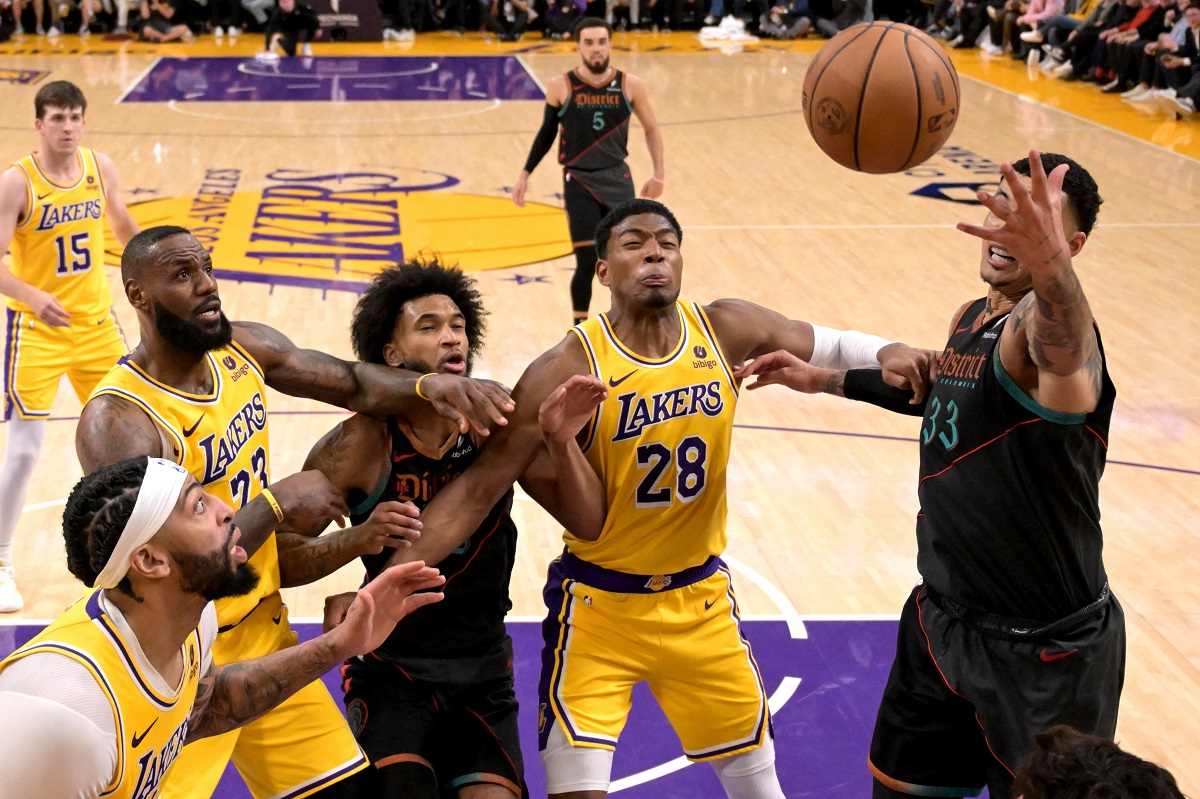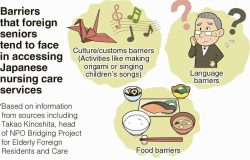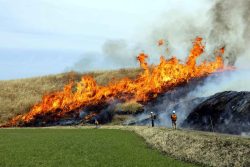
Los Angeles Lakers forwards LeBron James (23) and Rui Hachimura (28) battle for a rebound in the second half of a game against the Washington Wizards in Los Angeles on Feb. 29.
8:00 JST, March 11, 2024
The following is an installment of the “Letter from New York” column by Jacob Margolies, The Yomiuri Shimbun’s General Counsel for America. Having practiced law for over three decades in New York, he explores a variety of topics — cultural, economic and political — in and around the Big Apple, and examines issues that the United States, Japan and the world at large are facing.
At a professional basketball game in January at Brooklyn’s Barclays Center, I was surprised to see a man seated to my left waving a Finnish flag.
Looking around the arena, I noticed other flags and several men wearing a jersey with an unusual last name on the back. It seemed for a moment that the downtown arena had been taken over by a congress of Finns, all of them rooting for Lauri Markkanen, the best player on the Utah Jazz team.
Several rows below, I saw another group of fans, whom I took to be Filipino, cheering for Markkanen’s teammate Jordan Clarkson, whose mother, I would later ascertain, was from the Philippines. The night was yet another confirmation that basketball, sometimes referred to by New Yorkers as “the city game,” has become an international sport.
Perhaps I shouldn’t have been surprised. A little over a year earlier I’d been at a game where the Brooklyn Nets’ Yuta Watanabe scored 16 points in a game against the Memphis Grizzlies.
Watanabe grew up in Kagawa Prefecture and attended Jinsei Gakuen High School. A journeyman professional, he has subsequently moved on and is currently playing for Memphis, the fourth team he has played on in the National Basketball Association (NBA).
Another Japanese national, Rui Hachimura, plays for the Los Angeles Lakers. Sometimes, late at night, I watch him on television, playing alongside his teammate LeBron James, the greatest basketball player of the 21st century.
While basketball was invented in 1891 in Springfield, Mass., by James Naismith, the director of physical education at a local YMCA, New York City is the cradle of basketball civilization. The game’s popularity exploded early in the 20th century in the gyms and schoolyards of the city’s immigrant neighborhoods.
The game also proved popular with Blacks migrating to New York from the American South. Unlike baseball or American football, which require expensive equipment and a wide expanse of open space, basketball could be played on a small patch of asphalt, with only a ball and a metal hoop.
There is considerable literature exploring New York’s place in the evolution of basketball and the role the game has played in the social history of the city.
Pete Axthelm’s “The City Game: Basketball from the Garden to the Playgrounds,” published in 1970, describes both the championship season that year of the New York Knicks and the game as it was played outdoors in city’s parks. Rick Telander’s “Heaven is a Playground” (1976) details the year the author spent in the company of street basketball players in a ghetto neighborhood in Brooklyn. The best of the players he features, James “Fly” Williams, is currently in an upstate New York prison after being convicted of heading a heroin distribution ring.
Matthew Goodman’s “The City Game: Triumph, Scandal, and a Legendary Basketball Team” goes further back in time, exploring the 1949-50 City College of New York (CCNY) team. In 1950, basketball’s professional leagues were in their infancy, and the game was most popular as a college sport. Contests involving universities regularly drew 20,000 fans at Madison Square Garden.
CCNY was a tuition-free public college, and every member of its basketball team was either Jewish or African American. The team embodied the demographic changes that over the course of the first half of the 20th century had altered the face of the city. That year, the CCNY team won both year-end tournaments. In one of their most memorable games, CCNY routed the defending champion, the University of Kentucky, a segregated all-white Southern school.
In some respects, the game was a microcosm of social divisions that continue to divide the United States almost 75 years later. The following year, seven CCNY players were arrested for accepting money from gamblers in a point-shaving scandal. College basketball in New York never fully recovered.
Basketball Hall of Famers who grew up in New York and played professionally, starting in the 1950s until about 2000, are a roll call of the sport’s history: Bob Cousy, Connie Hawkins, Billy Cunningham, Lenny Wilkens, Nate Archibald, Bernard King and Chris Mullin. Looming over the rest are Dr. J (Julius Erving), who first became famous playing as a teenager in Harlem’s summer Rucker League, and Kareem Abdul-Jabbar, who held the NBA record for most points until he was surpassed by LeBron James in 2023.
But today the game’s great players no longer get their start playing in New York’s schoolyards. What changed? No doubt it is in large part because the rest of the world has embraced the sport. According to the International Basketball Federation (FIBA), 450 million people play the game today.
Michael Jordan’s games were televised to all corners of the globe, and he became the world’s most famous athlete. The 1992 Olympics “Dream Team,” which was the first to feature professional players from the United States and included Jordan, also did much to spread the gospel of basketball. On the 2023-2024 NBA opening night rosters, there were 125 NBA players from over 40 countries, and international players have won the league’s Most Valuable Player award for the last five seasons.
In 2005, my neighbor Lou Abrams told me about a 14-year-old boy who had a chance to be the next big thing in the world of basketball. His name was Lance Stephenson and he’d already been given the nickname “Born Ready.”
My neighbor wasn’t alone in his lofty evaluation. Lance was large, strong, fast, tough, hardworking and magnificently coordinated. Over the next three years, articles in newspapers heralded Lance’s arrival. One national magazine announced that he was so good that he could already be an NBA star.
Several times a year I’d accompany Lou to watch Stephenson play, sometimes traveling deep into Brooklyn’s rougher neighborhoods. The basketball was marvelous, but there was something dispiriting about having to go through a metal detector before being patted down by a school security officer. More than once, a teenager seeing an unfamiliar older white man, asked me hopefully, “Are you a scout?” Sometimes games had more police on hand than spectators.
And from Lou, I learned about the chaotic lives of several of the teenagers on the Lincoln High School team. Maybe New York, or at least this version of the city, wasn’t the best training ground for becoming a professional basketball player.
Meanwhile, in Europe many of the best prospects are apprenticed as teenagers to professional teams, where they receive expert coaching and skills training. Even across the United States, young teenage hoop prodigies are now often shipped off to prep schools and basketball academies in remote regions to prepare for a professional career.
Lance is now 33 years old. He never met the expectations set by New York’s basketball cognoscenti, but he has had a long and successful professional career and earned tens of millions of dollars. His most successful years were spent playing for the Indiana Pacers, but along the way he’s played professionally all over, including two years in Shenyang, China, for the Liaoning Flying Leopards. He is currently playing for the Iowa team in the G League, the official minor league organization of the NBA.
Although the game’s best players no longer grow up playing in the city’s schoolyards, many of basketball’s most enthusiastic and well-informed fans are New Yorkers. For the first time in over 20 years the Knicks, the city’s most popular team, is in the top tier of the NBA and the locals are hopeful.
The Knicks beloved TV game analyst, 78-year-old Walt “Clyde” Frazier, was a top player in the 1960s and 1970s. For the last 20 years, he has become known for his unique commentary suffused with rhyming and wordplay. About basketball in New York today, he might say that once again it is tantalizing and mesmerizing, dramatic and emphatic, razzling and dazzling, rising and surprising.
"JN Specialities" POPULAR ARTICLE
-

The Japan News / Weekly Edition (12/12-12/18)
-

English-language Kabuki, Kyogen Entertain Audiences in Tokyo; Portland State University Professor Emeritus, Graduates Perform
-

Noodle Dining Shunsai / Rich Oyster Ramen to Savor at Odasaga; Experienced 68-year-old Owner Creates Numerous Ramen Varieties
-

The Japan News / Weekly Edition (12/5-12/11)
-

People Keep Loved Ones’ Ashes Close in Special Jewelry, Small Urns as Unique Way to Memorialize Them
JN ACCESS RANKING
-

Keidanren Chairman Yoshinobu Tsutsui Visits Kashiwazaki-Kariwa Nuclear Power Plant; Inspects New Emergency Safety System
-

Imports of Rare Earths from China Facing Delays, May Be Caused by Deterioration of Japan-China Relations
-

University of Tokyo Professor Discusses Japanese Economic Security in Interview Ahead of Forum
-

Japan Pulls out of Vietnam Nuclear Project, Complicating Hanoi’s Power Plans
-

Govt Aims to Expand NISA Program Lineup, Abolish Age Restriction

























